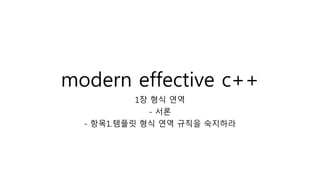
Modern effective cpp 항목1
- 1. modern effective c++ 1장 형식 연역 - 서론 - 항목1.템플릿 형식 연역 규칙을 숙지하라
- 2. 서론 – 형식연역(type deduction) • 타입 추론 아님? (이하 타입 추론) • C++98에서는 타입 추론에 관한 규칙들이 한 종류 • C++11 에서는 세 가지로 늘어남. • auto 를 위한 규칙 • decltype 을 위한 규칙 • 기존 규칙 약간 수정(템플릿 등등) • type을 변경하면 다른 곳에도 영향을 미칠 수 있음. • 조심해야함… • 이 장에서 auto와 decltype이 작동하는 방식을 알아보자!
- 3. 항목 1: 템플릿 타입 추론 규칙을 숙지하라. • auto 는 템플릿에 대한 타입추론을 기반으로 작동한다. • 덜 직관적인 경우가 있음. • 알아보기 어렵다는 뜻…
- 4. 항목 1: 템플릿 타입 추론 규칙을 숙지하라. 함수 템플릿의 선언의 예: template<typname T> void f(ParamType param); f(expr); • 여기서 두가지 추론이 사용되는데, 하나는 T에 대한 추론, • 하나는 ParamType에 대한 추론이다.
- 5. 항목 1: 템플릿 타입 추론 규칙을 숙지하라. • ParamType에 const 나 &같은 참조자 수식어가 들어감. • T 에는 타입이 들어간다. template<typename T> void f(const T& param); int x = 0; f(x); //T는 int , ParamType은 const &T // 파라미터 타입은 const int& 로 번역됨.
- 6. 항목 1: 템플릿 타입 추론 규칙을 숙지하라. • 이 때, ParamType이 결정되는 과정은 세가지 경우로 나눈다. 1. ParamType 이 포인터나 참조 형식이지만 universal refernce는 아닌 경우. 2. ParamType이 universal reference인 경우. 3. ParamType이 포인터도 아니고 참조도 아닌경우.
- 7. 1-1 ParamType 이 포인터나 참조 형식이지만 universal refernce는 아닌경우. • ParamType 이 포인터나 참조 형식이지만 universal refernce는 아닌경우. 1. 만일 expr부분이 참조 형식이면 참조 부분을 무시한다. 2. 그 다음 expr의 형식을 pattern-matching 방식으로 결정한다. 예> template <tyepname T> void f(T& param); int x = 27; const int cx = x; const int& rx = x; f(x) // int, int& f(cx) // const int, const int& f(rx) // const int, const int&
- 8. 1-1 ParamType 이 포인터나 참조 형식이지만 universal refernce는 아닌경우. • 둘째, 셋째 호출에서 T가 const int가 되기 때문에 매개변수는 자동으로 const int& 가 된다. 개이득! • const-ness가 유지된다. • 세 번째에서 T에 &가 무시된다는것도 명심. template <tyepname T> void f(T& param); int x = 27; const int cx = x; const int& rx = x; f(x) // int, int& f(cx) // const int, const int& f(rx) // const int, const int&
- 9. 1-1 ParamType 이 포인터나 참조 형식이지만 universal refernce는 아닌경우. • param이 const에 대한 참조로 간주되어 const는 T에서 제외됨. • rx의 참조성은 무시된다. template <tyepname T> void f(const T& param); int x = 27; const int cx = x; const int& rx = x; f(x) // int, const int& f(cx) // int, const int& f(rx) // int, const int&
- 10. 1-1 ParamType 이 포인터나 참조 형식이지만 universal refernce는 아닌경우. • 포인터는 const int*로 잘 해석됨. template <tyepname T> void f(T* param); int x = 27; const int *px = &x; f(&x); // int, int* f(px); // const int, const int*
- 11. 1-2 ParamType이 보편참조일때. • Universal reference 란? • lvalue reference와 rvalue reference 둘 다 가능한 상태 template <typname T> void f(T&& param); // universal ref.
- 12. 1-2 ParamType이 보편참조일때. • 이 부분은 항목24에서 다시 설명한대요… template< typename T> void f(T&& param); int x = 27; const int cx = x; const int& rx = x; f(x); //x는 lvalue, int&, int& f(cx); //cx는 lvalue, const int& , const int& f(rx); //rx는 lvalue, const int& , const int& f(27); //27은 rvalue, int, int&&
- 13. 1-3ParamType이 포인터도 아니고 참조도 아님. Template<typname T> void f(T param); • param은 주어진 인수의 복사본이 된다! • 이전처럼, expr 부분이 참조이면, 참조는 무시된다. • 참조성을 무시한후, const이면 const 역시 무시한다. • volatile 이면 그것도 무시한다. (? 항목 40참조)
- 14. 1-3ParamType이 포인터도 아니고 참조도 아님. • const 값을 지정해도, param은 const가 아니다. template <tyepname T> void f(T param); int x = 27; const int cx = x; const int& rx = x; f(x) // int, int f(cx) // int, int f(rx) // int, int
- 15. • 함수내에 전달되는 값은 무조건 복사되는 값이 된다. template <tyepname T> void f(T param); int x = 27; const int cx = x; const int& rx = x; f(x) // int, int f(cx) // int, int f(rx) // int, int 1-3ParamType이 포인터도 아니고 참조도 아님.
- 16. • 포인터 자체는 복사되어 const성이 사라짐. • 가리키는 대상에 대한 const성은 유지됨. template <tyepname T> void f(T param); const char* const ptr = “Fun with pointers”; f(ptr); // 포인터값 복사됨 1-3ParamType이 포인터도 아니고 참조도 아님.
- 17. 1-4 배열인수 • 배일과 포인터를 구분하지 않고 사용할 수 있는경우? • 많은 경우 배열이 첫 원소를 가리키는 포인터로 decay된다. • 그렇다면 템플릿에서는 어떨까?
- 18. 1-4 배열인수 • void f(T& param); 으로 선언했다면 실제로 전달! • const char (&)[13] 으로 추론된다. template <tyepname T> void f(T param); const char name[] = “J. P. Briggs”; // const char[13] const char * ptrToName = name; // decay f(name); //const char* // 비교 void myFunc (int param[]); //포인터로 decay
- 19. 1-4 배열인수 • 개멋있다… int keyVals[] = { 1,2,3,4,5} int sameSizeVals[ arraySize(keyVals) ]; //이런식으로 같은크기 선언도 가능 std::array<int, arraySize(keyVals)> sameSizeVals; //C++ style noexcept 는 항목 14참고. // 배열의 크기를 컴파일 시점에서 상수로 리턴하는 템플릿… template<typename T, size_t N> constexpr size_t arrSize(T(&)[N]) noexcept { return N; }
- 20. 1-5 함수 인수 • 함수형식도 함수 포인터로 decay 된다. void somFunc(int, double); template<typename T> void f1(T param); template<typename T> void f2(T& param); f1(somFunc); // param은 함수 포인터로 추론됨. // void (*)( int, double ) f2(somFunc); // param은 함수 참조로 연역됨. // void (&)( int, double )
- 21. 항목 1: 템플릿 타입 추론 규칙을 숙지하라. • 정리 • 은근 간단한데 • 왼값 관련 특별규정에 유의… • 포인터 decay 관련 해서 유의… • 대체 어떻게 추론 된건지 템플릿 결과물을 알고 싶으면 항목 4 참조.
- 22. 끝 • 감사합니다. • 출처 • 책 : modern effective c++